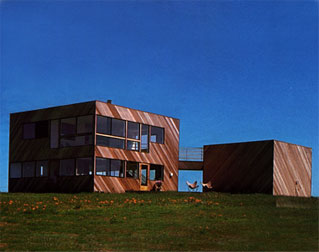| |
||||||
|
|
"A museum for the outdoor environment"
is how architect Kingwill aptly describes his house. The effect is
created by the all-white interior, above, which is surrounded by rows
of recessed windows that frame views of the landscape. To cut costs
and create an illusion of capaciousness, the interior is virtually
devoid of structural partitions; only the private living quarters
on the upper-level balcony and a lower-level bath are walled in. Fitted
into the open space at an angle, the balcony, above right, gives relief
from the cube shape and provides the only animated lines within the
serene enclosure. The slant is repeated in the hemlock flooring placed
on a diagonal. Like the pipe railing, stair risers are open to enhance
the flow of space and light. Fenestration abounds on the south and
west elevations, allowlng the sun to heat the interior. In addition
to energy savings, construction costs were further minimized by building
entire walls on the ground and then jacking them up in one piece. |
|||||
| RESUME | ||||||
| WHAT'S NEW! | ||||||
| THE DESIGN PROCESS | ||||||
| LINKS & RESOURCES | ||||||
| PUBLICATIONS | ||||||

